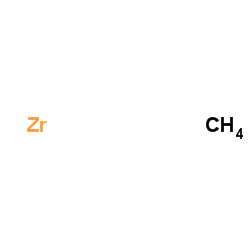Zirconium(IV) carbide
Modify Date: 2025-08-19 22:16:58

Zirconium(IV) carbide structure
|
Common Name | Zirconium(IV) carbide | ||
|---|---|---|---|---|
| CAS Number | 12070-14-3 | Molecular Weight | 103.235 | |
| Density | 6.73 | Boiling Point | 5100ºC | |
| Molecular Formula | CZr | Melting Point | 3540ºC | |
| MSDS | Chinese USA | Flash Point | N/A | |
| Symbol |


GHS02, GHS07 |
Signal Word | Danger | |
| Name | Zirconium carbide |
|---|---|
| Synonym | More Synonyms |
| Density | 6.73 |
|---|---|
| Boiling Point | 5100ºC |
| Melting Point | 3540ºC |
| Molecular Formula | CZr |
| Molecular Weight | 103.235 |
| Exact Mass | 101.904701 |
| LogP | 0.08130 |
|
Section 1: Product Identification Chemical Name:Zirconium carbide (99+%-Zr) CAS Registry Number:12070-14-3 Formula:ZrC EINECS Number:235-125-1 Chemical Family:metal carbides Synonym:none
Section 2: Composition and Information on Ingredients IngredientCAS NumberPercentACGIH (TWA)OSHA (PEL) Title compound12070-14-3100%5mg/m3 (as Zr)5mg/m3 (as Zr) Section 3: Hazards Identification Emergency Overview:May be irritating to skin, eyes and mucous membranes. Primary Routes of Exposure:Ingestion Eye Contact:May cause mild to moderate irritation of the eyes. Skin Contact:May cause slight to mild irritation of the skin. Inhalation:Dust may be irritating to the nose, mucous membranes and respiratory tract. Ingestion:No information is available on the physiological effects of ingestion. Acute Health Affects:May be irritating to skin, eyes and respiratory tract. Chronic Health Affects:No information available on long-term chronic effects. NTP:No IARC:No OSHA:No SECTION 4: First Aid Measures Immediately flush the eyes with copious amounts of water for at least 10-15 minutes. A victim may need Eye Exposure: assistance in keeping their eye lids open. Get immediate medical attention. Wash the affected area with water. Remove contaminated clothes if necessary. Seek medical assistance if Skin Exposure: irritation persists. Remove the victim to fresh air. Closely monitor the victim for signs of respiratory problems, such as difficulty in Inhalation: breathing, coughing, wheezing or pain. In such cases seek immediate medical assistance. Seek medical attention immediately. Keep the victim calm. Give the victim water (only if conscious). Induce Ingestion: vomiting only if directed by medical personnel. SECTION 5: Fire Fighting Measures Flash Point:no data Autoignition Temperature:no data Explosion Limits:no data Extinguishing Medium:carbon dioxide, foam or dry powder If this product is involved in a fire, firefighters should be equipped with NIOSH approved positive pressure Special Fire Fighting Procedures: self-contained breathing apparatus. Hazardous Combustion andIf involved in a fire this material may release toxic and corrosive fumes. Decomposion Products: Unusual Fire or Explosion Hazards: Flammable. No unusual fire or explosion hazards. SECTION 6: Accidental Release Measures Spill and Leak Procedures:Sweep up the solids and dispose of properly. SECTION 7: Handling and Storage Handling and Storage:Store the material in a sealed container. Keep away from heat. SECTION 8: Exposure Controls and Personal Protection Eye Protection:Always wear approved safety glasses when handling a chemical substance in the laboratory. Skin Protection:Wear protective clothing and gloves. Ventilation:If possible, handle the material in an efficient fume hood. If ventilation is not available a respirator should be worn. The use of respirators requires a Respiratory Respirator: Protection Program to be in compliance with 29 CFR 1910.134. Ventilation:If possible, handle the material in an efficient fume hood. Additional Protection:No additional protection required. SECTION 9: Physical and Chemical Properties Color and Form:3 micron black powder Molecular Weight:103.23 Melting Point:3540° Boiling Point:5100°C Vapor Pressure:no data Specific Gravity:6.73 Odor:none Solubility in Water:insoluble SECTION 10: Stability and Reactivity Stability:air and moisture stable Hazardous Polymerization:No hazardous polymerization. Conditions to Avoid:none Incompatibility:oxidizing agents and halogens Decomposition Products:carbon monoxide, carbon dioxide and zirconium oxide. SECTION 11: Toxicological Information RTECS Data:No information available in the RTECS files. Carcinogenic Effects:no data Mutagenic Effects:no data Tetratogenic Effects:no data SECTION 12: Ecological Information Ecological Information:No information available SECTION 13: Disposal Considerations Disposal:Dispose of according to local, state and federal regulations. SECTION 14: Transportation Shipping Name (CFR):Flammable solid, Inorganic, N.O.S. Hazard Class (CFR):4.1 Additional Hazard Class (CFR):NA Packaging Group (CFR):III UN ID Number (CFR):UN# 3178 Shipping Name (IATA):Flammable solid, Inorganic, N.O.S. Hazard Class (IATA):4.1 Additional Hazard Class (IATA):NA Packaging Group (IATA):III UN ID Number (IATA):UN# 3178 SECTION 15: Regulatory Information TSCA:Listed in the TSCA inventory. SARA (Title 313):Title compound not listed Second Ingredient:none SECTION 16 - ADDITIONAL INFORMATION N/A |
| Symbol |


GHS02, GHS07 |
|---|---|
| Signal Word | Danger |
| Hazard Statements | H228-H302 + H312 + H332 |
| Precautionary Statements | P210-P261-P280-P301 + P312 + P330-P370 + P378 |
| Personal Protective Equipment | dust mask type N95 (US);Eyeshields;full-face particle respirator type N100 (US);Gloves;respirator cartridge type N100 (US);type P1 (EN143) respirator filter;type P3 (EN 143) respirator cartridges |
| Hazard Codes | F:Flammable;Xn:Harmful; |
| Risk Phrases | R11;R20/21/22 |
| Safety Phrases | S16-S27-S33-S36/37/39 |
| RIDADR | UN 3178 |
| WGK Germany | 3 |
| Packaging Group | III |
| Hazard Class | 4.1 |
| HS Code | 2849909000 |
| HS Code | 2849909000 |
|---|
| zirconiumcarbide(zrc) |
| ZIRCONIUM CARBIDE: |
| ZRC A |
| MFCD00049640 |
| ZRC B |
| Zirconiumcarbide(-Zr) |
| Zirconium carbide (ZrC) |
| ZRC AX |
| EINECS 235-125-1 |
| Zirconium(IV) carbide |
| Zirconium Carbide,-325 Mesh |

